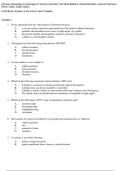Examen
Human Geography Landscapes of Human Activities 13th Edition By Mark Bjelland, Daniel Montello, Jerome Fellmann, Arthur Getis, Judith Getis (Test Bank)
- Grado
- Institución
Human Geography Landscapes of Human Activities 13e Mark Bjelland, Daniel Montello, Jerome Fellmann, Arthur Getis, Judith Getis (Test Bank) Human Geography Landscapes of Human Activities 13e Mark Bjelland, Daniel Montello, Jerome Fellmann, Arthur Getis, Judith Getis (Test Bank)
[Mostrar más]



